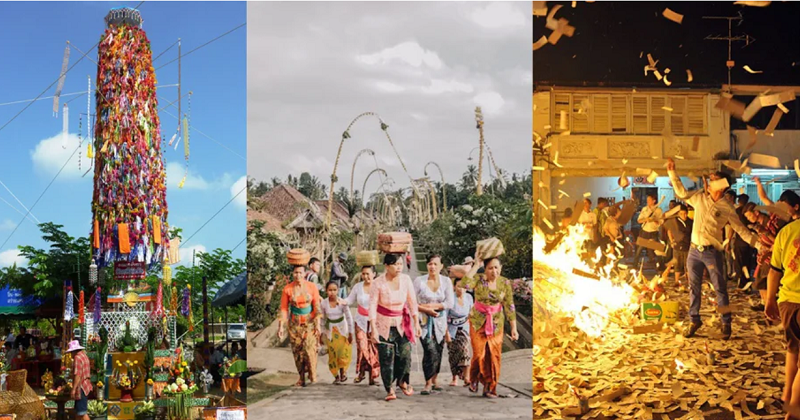Here’s How The Dead Are Remembered By The Living In Southeast Asia
Source: Mashable SE, by Sukhbir Cheema
On the 15th night of the seventh month in the Chinese lunar calendar, practitioners of Buddhism and Taoism around the world begin preparations for the Ghost Day.
The Ghost Day happens in what is called the Ghost Month. This is the month when ancestors who have long passed pay their visits to their descendants.
According to Chinese belief, the gates of Heaven and Hell are opened to allow those from the realm of the spirit to visit the living.
In Malaysia and Singapore, this festival is commonly called the Hungry Ghost Festival. Tracing its roots all the way to China, other countries in Southeast Asia also have their own version of the festival.
Vietnam – Tết Trung Nguyên

Similar to the Chinese, the Vietnamese offer fruits, food and votive paper offerings to wandering spirits during the Tết Trung Nguyên.
According to Vietnamese folklore, once in a year the King of the Underworld allows spirits to enter the realm of the living to merry make. Due to this, the month is commonly associated with bad luck thanks to some mischievous spirits. Vietnamese usually have do’s and don’ts that must be adhered to to prevent falling prey to these spirits.
Among some of the taboos are not hanging washed clothes at night, avoid shouting a person’s name at night, not partaking in any of the offering reserved for the spirits, avoid picking notes or coins during this month, and this one is for the ladies: Do not shave your legs. Vietnamese believe the hair on the legs will protect women from the spirits.
Cambodia – Pchum Ben

Cambodia is the only country to celebrate their version of the Hungry Ghost Festival in October.
Unlike other nations, the Cambodians follow the Khmer calendar. The
festival occurs following the end of Vassa, the Buddhist lent.
During this month, Buddhist monks chant the sutras in the Pali language
continuously without sleeping in preparation for King Yama – the god of
death – to open the gates of the spirit realm.
Just like other cultures, food offerings are made to appease the souls of the dead.
Laos – Boun Haw Khao Padap Din

This festival is celebrated a little differently. While other cultures pay their respects to the dead, the people of Laos celebrate the living and those who’ve passed on.
Celebrated on the 15th day of the 9th month of the Lao calendar, the
Boun Haw Khao Padap Din is a day when families prepare large pots of
sticky rice mixed with sweetened coconut milk.
The rice is then wrapped into tiny packets using banana leaf. Next,
these packets are steamed and distributed to their family and friends.
Some also offer them to monks.
The day is marked to pay respect to all those who’ve passed including those who have no relatives to remember them by. The people of Laos also pay homage to the earth god, Maethaulanii.
Thailand – Gin Salat

The people of Thailand honour those who have passed on by building
“salats” made out of items that they used to use when they were alive.
Stuff such as toothpaste, toothbrushes, clothes, and items that might be needed in the realm of the dead are erected.
According to this writer,
the festival is not common. In fact, information on this day can’t be
found in guidebooks. This is because it’s an extremely old practise.
Now, this is only celebrated in certain areas in Thailand such as
Lamphun.
Indonesia – Hari Raya Galungan

Commonly celebrated in Bali, the Galungan is celebrated with the
erection of penjor, bamboo poles, which are decked with offerings for
the dead.
These colourful poles are placed on the side of streets, in front of
shops and houses to fill the tummies of spirits visiting earth.
There is a legend about a great Balinese king, named Mayadenawa who did
not allow the practise of Hinduism in his land. He was so strong that
even the mighty Majapahit armies could not remove him from power.
He was eventually defeated when Lord Indra joined the fight. This
festival is also celebrated as a day of victory for the Balinese.
On this day, animals are offered to remove bad luck. These offerings are
then cooked into delicious meals which families then enjoy.
Malaysia & Singapore – The Hungry Ghost Festival

Usually celebrated in the month of August, this month is when you’ll find offerings and incense being burned at street corners.
The Chinese believe that wandering spirits will be able to partake in the foods to appease them.
Some of these offerings which mainly consists of food and hell money
are burned as a mark of respect for wandering spirits who don’t have
homes or families to remember them by.
In some places, live concerts and Chinese opera performances are held to entertain the dead and the living.

Prayers for Tai Su Yeah, the King of Hell and his generals Tua Pek and Zhi Pek are also held on this day. The trio are responsible in ensuring the spirits do not harm the living.
Despite their variations, these festivals have one thing in common: To remember those who’ve passed on.


